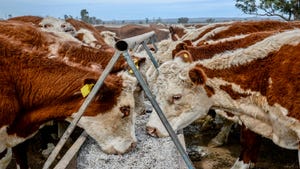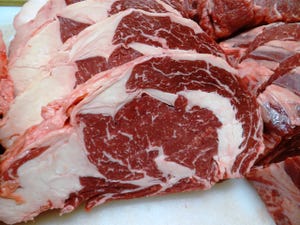NMSU Looks At Genetics Of Brisket Disease
The nation's highest altitude beef cattle research facility managed by New Mexico State University (NMSU) at the Valles Caldera National Preserve in northern New Mexico is determining if there are DNA markers that will identify cattle genetically predisposed to develop
September 3, 2010

The nation's highest altitude beef cattle research facility managed by New Mexico State University (NMSU) at the Valles Caldera National Preserve in northern New Mexico is determining if there are DNA markers that will identify cattle genetically predisposed to develop hypertension while at high elevations.
Cattle, like humans, can be genetically predisposed for hypertension at higher altitudes, known as bovine high altitude disease (HAD) or brisket disease, when they graze above 7,000 ft. elevation for extended periods. The inability to process oxygen efficiently is a key health issue that hampers beef cattle operations in the Rocky Mountain region.
"Grazing cattle at high elevations comes with inherent risk due to their susceptibility of developing hypertension," says Manny Encinias, NMSU Extension beef cattle specialist and director of the high altitude research facility.
Most producers don't know if individual cattle will have problems grazing at high elevations until the animal shows clinical symptoms. Unfortunately, in most situations, the discovery and disease confirmation is only after the death of the animal. And, death and performance losses associated with HAD annually add up to more than $60 million in the Rocky Mountain region.
"Our long-term goal is to develop indicators and tools that beef producers can use to select cattle that will thrive at high elevations," says Encinias, "We believe HAD is a condition impacted by multiple factors and teaming up with multidiscipline experts, universities and progressive beef cattle producers is a key to making rapid progress on managing this disease."
NMSU's College of Agricultural, Consumer and Environmental Sciences is coordinating the facility that involves researchers from three universities – NMSU, Colorado State University and the University of Illinois – and cattle breeders from several states.
A national expert on bovine HAD, Tim Holt who was a veterinarian and assistant professor at Colorado State University's School of Veterinary Medicine and Biomedical Science, has been actively involved at the facility since 2009 by performing pulmonary arterial pressure (PAP) tests on cattle to evaluate individual adaptation to the high altitude. The PAP test is presently the beef industry's diagnostic tool of choice, as it detects early signs of hypertension through an animal's blood pressure.
Establishing this research program at the Preserve has given Encinias and Holt the most unique venue in the U.S. to study HAD.
"Mountain grazing is a high-stress environment for cattle. The higher the elevation the more accurate the PAP test data," Holt says. "This is why the Valles Caldera National Preserve is such an important place to conduct this research."
At more than 8,500 ft. in elevation, the Top of the Valle research facility is the highest centralized facility in the U.S. focused on studying HAD. Abundant and highly nutritional grass also provides a natural grazing environment that is a typical grazing scenario beef cattle encounter grazing high altitude pastures.
"The Valles Caldera gives us altitude and a natural grazing environment to evaluate numerous factors and scenarios to better understand HAD," Encinias says.
"We are interested in nutrition, environment, water and anything else that might be influencing a low oxygen setting," Holt says. "We’re also looking at the pregnancy rate to see if the elevation is impacting the reproductive process, such as if the cow isn’t pregnant after insemination do they have high PAP scores. Is that a factor to their not being pregnant?"
The newest addition to the research team is genetics researcher Jonathan Beever, a University of Illinois associate professor whose research has been instrumental in the development of diagnostic tools to rapidly detect genetic disorders in multiple breeds of beef cattle. Beever will analyze DNA samples gathered from the cattle during the PAP testing process to determine genes that influence the susceptibility to the potentially deadly condition. He is comparing genetic information from animals suffering from HAD to those not showing signs when given the PAP test.
"With the DNA marker information we would be able to test any animal regardless of where it is raised, or its pedigree, and be able to say whether this animal will survive when you take him to a higher altitude," Beever says.
On Saturday, Sept. 11, the Top of the Valle will host its second annual high-altitude bull and female sale. This year, 35 registered, yearling and two-year-old bulls, as well as 70 registered bred heifers, that have been PAP and performance-tested on 100% grass for 84 days, qualified for the annual sale at the Valles Caldera National Preserve. The silent auction is from 10 a.m. to 2 p.m., with a live animal bid off at 2 p.m. Get more info at highcountrybeef.nmsu.edu.
-- NMSU release
You May Also Like



